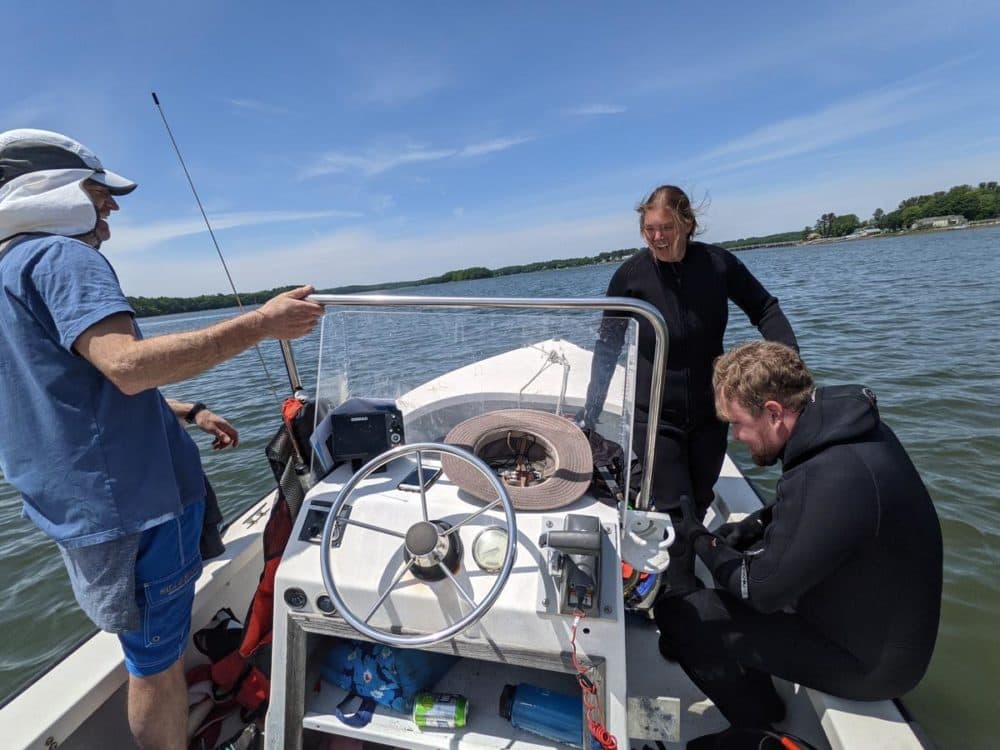Advertisement
New Hope For N.H.'s Great Bay As Towns, Scientists Begin Collaborating On Restoration
Resume
After decades of declining water quality, there’s new optimism surrounding the health of Great Bay. A new partnership between towns, scientists and advocacy groups has people thinking for the first time that they might find long-term solutions to restore the estuary.
It will be a boon to ongoing research projects, like one at UNH that's piloting ways to transplant a crucial underwater plant within the bay.
Eelgrass can be seen across much of the estuary, floating in wavy green tendrils just beneath the water.
On a recent sunny day, UNH researcher Kalle Matso piloted a skiff delicately over one of these patches of grass, in the shallows off Dover Point Road and Route 4. The native grass is a linchpin of this kind of ecosystem, Matso said. Its roots hold the bottom of the bay together and keep the water clear.
"It also stores carbon, it buffers us from storms, it provides all this habitat," Matso said. "We were out harvesting this morning, every time I dug in my hands to get some eelgrass, tiny little creatures would jump out."
Matso said the grass is like a nursery — and when it's healthy, it keeps the bay resilient against stresses like development and climate change.
But it's very vulnerable to pollution.
Scientists estimate that close to half the eelgrass in the bay has disappeared since the mid-90s. Sewage plants and septic tanks, road runoff, fertilizer — they all put out nitrogen that chokes out eelgrass.
'Nothing Is Off The Table'
Now, there's new hope that this long decline can be reversed. Earlier this year, a dozen towns around the bay finalized a plan to work towards a collective goal to limit the pollution they put into the estuary.
Federal regulators who set that limit say it's one of the first agreements of its kind. It's unusual because all the towns share the same goal, but each gets to decide exactly how they'll meet it.
"Rather than having nitrogen regulated only at the wastewater treatment plant, we've decided to look at it more holistically," said Gretchen Young, the environmental projects manager for the city of Dover.
In the past, she said, regulators and communities like hers have focused on their clearest single source of nitrogen pollution: wastewater. But they've all but maxed out how much they feel like they can invest in improving their wastewater plants.
This new plan encourages them to try other things: better street sweeping and stormwater systems, fertilizer rules, rain gardens and more.
"It's opened up a real lot of dialogue between the people who are managing these efforts," said Terry Demarais, the city engineer in Portsmouth, another community that’s participating. "And I think at this point there's really nothing that's off the table right now."
One thing they’ve all agreed to do is fund more robust monitoring of conditions in Great Bay. That will provide a lot more data for scientists who have long struggled to get the big picture on how the bay is changing and what interventions are helping.
Melissa Paly, the Great Bay-Piscataqua Waterkeeper with the Conservation Law Foundation, said it didn't help that for years, towns and stakeholders fought over who was responsible and who should pay. Now, they're finally ready to get to work on more ambitious solutions.
"We've been on a downward spiral, doing a lot of work to clean up pollution," she said. "Now we want to see if we can get this ecosystem to start functioning again, to rebuild and restore."
The towns have to finalize their chosen interventions and monitoring regimen in what's known as an adaptive management plan, due to the EPA by the end of next month.
First Steps Toward Restoration
In the meantime, Kalle Matso and a research team from UNH and Boston University are continuing their pilot eelgrass restoration project: testing ways to transplant the grass and regrow it where it's died off.
"We harvested around 1,200 plants and then we'll put those into sites that have been deemed good restoration sites," Matso said.
The healthy grass came from a bed in the Piscataqua River that will soon be destroyed by construction of a new turning basin at the Port of New Hampshire in Portsmouth, Matso said — so they're repurposing the plants while they can.
Out on the water, just offshore from highways, backyards and oyster farms, Matso watched his divers hop off the boat and walk through the light current. Standing waist-deep in their wetsuits, they began the slow work of science, calling markers back to the boat.
Matso said this small step toward restoration will pay off much more thanks to all the new investments by the towns around the bay.
"We're all just really happy that the municipalities are being so [proactive] and working hard to make this adaptive management thing work," Matso said. "Only some of that could have happened without the municipalities stepping up."
After years of uncertainty, people like Matso are starting to imagine that Great Bay could be made healthy again.
This story is a production of the New England News Collaborative. It was originally published by New Hampshire Public Radio on June 8, 2021.